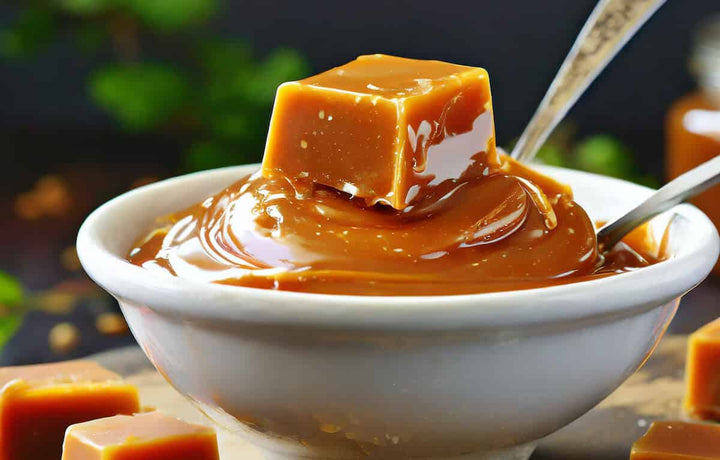Salted caramel, a confectionery phenomenon tantalising taste buds with its perfect balance of sweetness and saltiness, has an intriguing history spanning recent decades.
It began in France, a country renowned for its culinary prowess, where a forward-thinking pastry chef dared to challenge the conventional boundaries of sweet and savoury.
In this post, we will look into the fascinating history of salted caramel, uncovering the details of its invention and the creative mind behind it.
We'll explore how this delectable confection found its way into people's hearts (and palates) worldwide, evolving from a hidden gem in Brittany, France, to a global culinary trend.
Who Invented Salted Caramel?
Salted caramel was invented by Henri Le Roux, a French chocolatier and caramélier.
The invention took place in the 1970s in Brittany, a region in France famous for its butter and sea salt.
Henri Le Roux sought to create a confection that would stand out in the competitive world of French sweets.
Drawing inspiration from the rich dairy produce of Brittany, he decided to combine the region's renowned salted butter with caramel.
The result was a revolutionary creation: salted butter caramel.
He added crushed nuts to the caramel, creating CBS (Caramel au Beurre Salé), or Salted Butter Caramel.
This creation quickly gained popularity in Brittany, across France, and eventually worldwide.
The success of Le Roux's salted caramel sparked a global trend.
It became a flavour sensation in various confections and desserts, from chocolates and candies to sauces and ice creams.
The appeal of salted caramel lies in its balance of contrasting tastes - the sweetness of caramel is perfectly offset by the hint of sea salt, creating a complex and indulgent flavour experience.

When Was Salted Caramel Invented?
Salted caramel, a popular flavour in desserts and confections, originates in France.
It was invented by a French pastry chef, Henri Le Roux, in the early 1980s.
Le Roux, based in Brittany, a region known for its quality salted butter, combined this local ingredient with caramel to create a new and distinct confection.
What is Salted Caramel?
Salted caramel is a popular confection that combines caramel's rich, sweet taste with a hint of salt, usually sea salt.
Caramel is made by cooking sugar until it turns into a deep amber liquid, to which butter and often cream are added.
Adding salt to this mixture creates a delightful contrast that enhances the sweet flavour of the caramel, resulting in a complex and moreish taste experience.
This confection can be found in various forms, from a soft, gooey filling in chocolates and pastries to a thick, drizzle-able sauce for desserts like ice cream and cakes.
The appeal of salted caramel lies in its balance of flavours – the sweetness is offset by the savoury notes of the salt, which not only adds depth to the taste but also accentuates the caramel's buttery richness.

What is the Future of Salted Caramel?
The future of salted caramel appears bright and promising, as it continues to be a highly popular and versatile flavour in the culinary world.
Its unique blend of sweet and salty notes has captured the taste preferences of a broad audience, making it a staple in both home kitchens and gourmet establishments.
Looking ahead, we can expect to see salted caramel's influence expand in several ways:
-
Innovation in Recipes: Chefs and food innovators will likely continue experimenting with salted caramel in various culinary applications, from desserts and confectionery to savoury dishes, adding complexity and a gourmet touch.
-
Health-Conscious Adaptations: As health and dietary concerns become more prominent, salted caramel products may rise that are tailored to be lower in sugar, vegan, or made with alternative sweeteners and ingredients.
-
Global Fusion: The flavour of salted caramel could merge with diverse culinary traditions, leading to unique and innovative combinations that reflect global tastes and cultural fusions.
-
Seasonal and Artisanal Variations: We may see more seasonal variations of salted caramel, incorporating local and seasonal ingredients. Artisanal producers might also experiment with different types of salts and sugars to create unique flavour profiles.
-
Sensory Experiences: Salted caramel could become a part of more immersive and multi-sensory dining experiences, playing with textures, presentations, and pairings with other flavours.
Salted caramel's future will likely be characterised by creative culinary explorations and adaptations, maintaining its popularity while evolving to meet changing consumer preferences and trends.
What Does Salted Caramel Taste Like?
Salted caramel offers a rich and complex flavour profile, a harmonious blend of sweet and salty tastes.
The taste of caramel is sweet and buttery, with a deep, toasted sugar flavour that comes from caramelised sugar.
This sweetness is enriched by adding butter, which gives it a creamy and indulgent quality.
Cream or milk, often in caramel recipes, contributes to its smooth and velvety texture.
Salted caramel's defining characteristic is salt addition, typically sea salt, which introduces a savoury element.
This saltiness cuts through the sweetness, balancing and enhancing the overall flavour.
The result is a delightful contrast that heightens the taste experience.
The salt amplifies the caramel's sweetness and brings out its buttery notes, creating a more complex and rounded flavour.
Where Can You Buy Tasty Chocolate?
Whitakers Chocolates, renowned for our long history in crafting delicious and affordable chocolates, offers a range of options suitable for everyone, including vegetarian, vegan, and gluten-free choices.
Our top-selling products, such as indulgent Coffee Creams, Neapolitans, Chocolate Wafer Thins, Stem Ginger and Luxury Chocolate Truffles, are perfect for enhancing your mocha coffee experience.
Click here to see our delicious range of chocolate…
Some Notes From an Expert Chocolatier
I've always found the fusion of different flavours and textures at the heart of innovative chocolate creation.
One of my favourites is incorporating sweet confectionery ingredients into chocolate, which opens up a world of delightful taste experiences.
One such combination I often explore is blending rich, creamy chocolate with various sweet treats, such as toffee, caramel, and salted caramel.
The contrast between the smooth, luxurious chocolate and the rich, buttery sweetness of confectionery, enhanced with a hint of salt, creates an irresistible complexity in flavour.
This balance of sweet and salty enhances the chocolate's depth and brings a surprising twist that delights the palate.
In my journey of crafting chocolates, I have found that using high-quality ingredients and paying attention to the balance of flavours are key.
Final Notes On the Invention of Salted Caramel
The invention of salted caramel represents a pivotal moment in the world of confectionery, blending the sweet richness of caramel with the subtle sharpness of salt to create a flavour sensation that has captured the hearts of food enthusiasts worldwide.
Henri Le Roux, a visionary French chocolatier, is credited with this ingenious creation in the 1970s in Brittany, France, a region renowned for its exceptional butter and sea salt.
Since its inception, salted caramel has transcended its humble origins to become a global culinary phenomenon.
Its versatile nature has allowed it to be featured in various desserts, from luxurious chocolates and indulgent ice creams to sophisticated pastries and gourmet sauces.
The success of salted caramel lies in its perfect balance of flavours, appealing to a wide range of palates and inspiring countless variations and innovations in sweet and savoury dishes.











